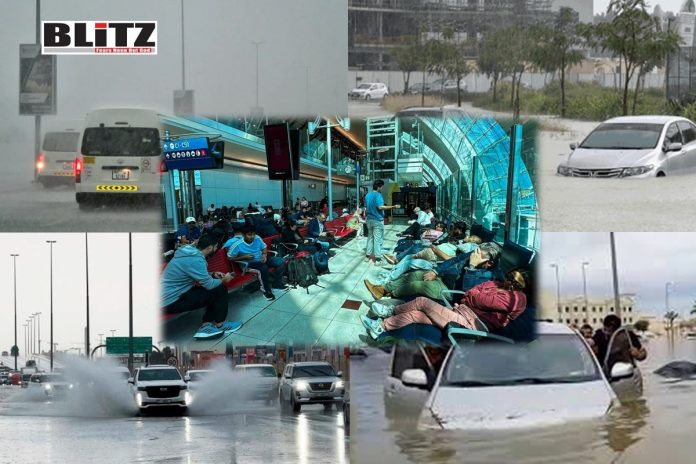Dubai, often celebrated for its iconic skyline, opulent shopping avenues, and state-of-the-art infrastructure, found itself grappling with an unprecedented challenge as it was hit by record-breaking rains. The deluge wreaked havoc on the city’s transportation networks, brought its bustling airport to a standstill, and tragically led to loss of life. As the world faces the increasing impacts of climate change, this extreme weather event raises pressing questions about Dubai’s resilience and preparedness for such catastrophic events.
On Tuesday, April 16, Dubai was drenched by an astonishing 254 millimetres of rainfall, an amount that typically would span over two years for the desert nation of the United Arab Emirates. This extraordinary amount of rain turned Dubai’s usually dry landscape into a series of flooded streets and highways, causing extensive traffic jams and stranding commuters.
The severe weather conditions resulted in a tragic loss when a 70-year-old man in Ras Al-Khaimah was swept away in his car by the raging floodwaters. This heartbreaking incident serves as a grim reminder of the life-threatening risks posed by extreme weather events and the need for heightened awareness and safety measures.
Dubai’s status as an international travel hub was severely impacted by the torrential rain. The Dubai International Airport, renowned as the busiest airport globally for international traffic, faced significant disruptions. Authorities urged passengers to avoid unnecessary travel to the airport, with an official stating, “Flights continue to be delayed and diverted… We are working tirelessly to restore operations amid these challenging conditions.”
In response to the chaotic situation, Emirates, Dubai’s flagship airline, took the unprecedented step of cancelling all check-ins on Wednesday. This decision left thousands of passengers stranded or delayed, as both airport staff and travelers grappled with the logistical nightmare caused by the flooding. Access roads leading to the airport were inundated, and several metro services, a key transport link for passengers, were halted due to safety concerns.
The scenes at the airport were chaotic, with weary travelers navigating long taxi queues and crowded terminals. Many passengers faced uncertainty and anxiety as they awaited updates on their flights, with scores of flights experiencing delays, cancellations, or diversions during the height of the storm.
The extreme weather conditions were not confined to Dubai alone. Neighboring countries such as Bahrain and Oman also experienced the wrath of the storms. Oman, which bore the brunt of the storms before they reached the UAE, reported a devastating toll with 18 fatalities, including several children. The storms left a path of destruction across the region, causing extensive damage to infrastructure and claiming numerous lives.
With climate change increasingly impacting global weather patterns, experts are drawing connections between these extreme events and the broader climate crisis. Climatologist Friederike Otto, specializing in assessing climate change’s impact on extreme weather events, commented that it was “highly likely” that global warming had intensified these storms, exacerbating their destructive power.
The significance of the rainfall was further emphasized by official meteorological reports, which indicated that this was the highest recorded rainfall since records began in 1949. This surpasses all historical data, even predating the formation of the UAE in 1971, marking it as an unprecedented meteorological event.
Dubai’s recent ordeal with record-breaking rainfall has prompted introspection and calls for action regarding the city’s infrastructure and preparedness for extreme weather events. Despite Dubai’s reputation for cutting-edge technology and modern architecture, this event has exposed vulnerabilities in its infrastructure and emergency response mechanisms.
City planners, policymakers, and infrastructure developers face the daunting task of reassessing and enhancing existing systems to better withstand future extreme weather events. Potential measures could include upgrading drainage systems, bolstering flood defenses, and implementing stricter building codes to ensure structures are more resilient to flooding and other natural disasters.
Dubai’s recent encounter with record-breaking rainfall serves as a stark wake-up call for cities worldwide about the urgent need to adapt to the challenges posed by climate change. While Dubai has demonstrated resilience in the face of adversity, there is an imperative to implement proactive measures and investments to mitigate the risks associated with extreme weather events. As the global community continues to confront the realities of a changing climate, cities like Dubai must evolve and innovate to ensure a sustainable and resilient future for their residents.




